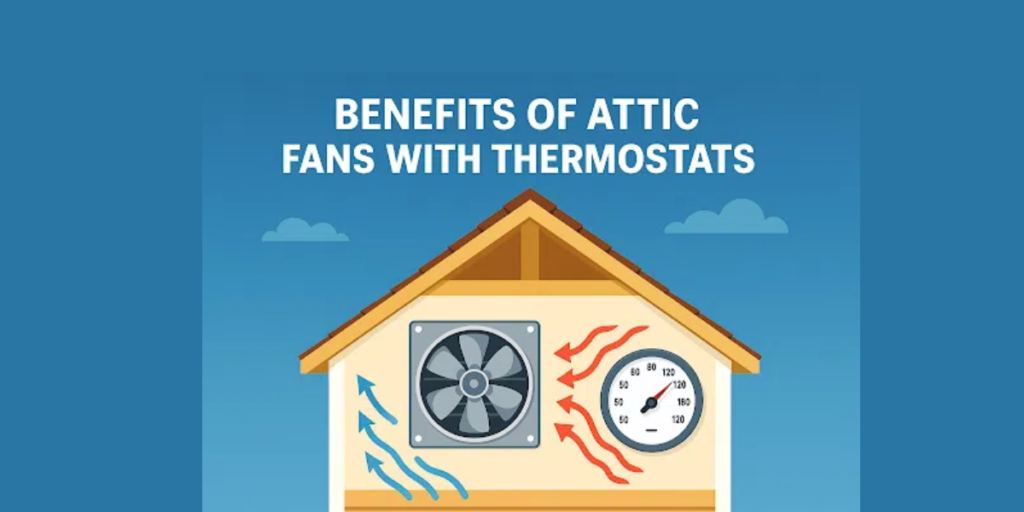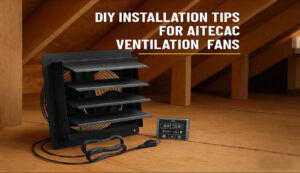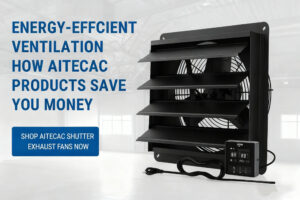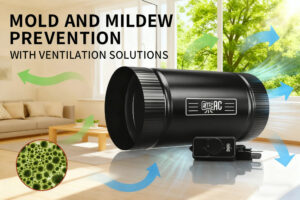During summer, they reduce attic heat, protecting asphalt shingles and extending roof life. Thermostat-controlled fans automatically turn on when temperatures rise, maintaining balanced airflow without manual effort. This article will help you understand how they work, their benefits, and how to choose the right attic fan for your home’s unique needs.
What is an attic fan with a thermostat?
A thermostat controlled attic fan is a powered ventilation device that regulates attic temperature automatically. Unlike manual fans that need to be turned on and off, these systems have built in thermostats that turn on when the attic reaches a set temperature, usually between 80°F to 120°F.
These fans, also called Power Attic Ventilators (PAVs), pull hot air out of the attic and pull in cooler air from intake vents. This exchange maintains a consistent comfortable temperature in the attic and across the home.
Advanced models also have humidistats that respond to excess moisture. This dual protection makes these fans essential in both summer and winter, preventing heat buildup in hot weather and reducing condensation risks in cold seasons.
How thermostat controlled fans differ from regular fans
Unlike standard fans that need to be manually operated, thermostat controlled attic fans operate automatically based on environmental conditions. This is their biggest advantage over other ventilation methods.
The differences are:
-
- Automatic operation: Thermostat fans only turn on when needed, while regular fans run continuously or need to be manually switched.
-
- Adaptive performance: Some advanced models adjust their operation incrementally—low speed at 80°F, medium at 100°F, high at 110°F.
-
- Energy efficiency: By selective operation, thermostat controlled fans use power only when needed, while standard fans run regardless of temperature.
-
- Integration capabilities: Many thermostat fans can connect to humidity sensors (humidistats) to address moisture concerns along with temperature.
Also these fans often have advanced features like wireless controls that can be operated from up to 100 feet away and ClimaSense technology that allows ventilation for up to 4 hours after sunset.
Common use cases in homes and buildings
Thermostat controlled attic fans serve multiple purposes in residential and commercial buildings:
-
- Temperature management: They excel at preventing heat buildup in attic spaces that can reach extreme temperatures in summer.
-
- HVAC support: By reducing attic temperature these fans reduce the thermal load on air conditioning systems in the building.
-
- Moisture control: Models with humidity sensors prevent condensation that can lead to mold growth and structural damage.
-
- Roof protection: Proper ventilation extends the life of roofing materials by reducing heat exposure that can deteriorate shingles.
Thermostat controlled attic fans come in various mounting options. Roof mounted versions install directly on the roof surface, gable mounted options fit into the triangular wall sections at roof ends. Solar powered options are also available that operate during daylight hours when heat accumulation is highest.
How attic fans with thermostats work
Attic fans with thermostats are smart ventilation systems that automatically keep your attic at the perfect temperature and humidity. These fans have built in thermostats that monitor the attic temperature. When it gets above a set point (usually between 95°F and 115°F) the fan turns on and blows out the hot air. When it drops below that point, the fan turns off, no need to touch anything.
Many models have multiple speed settings or advanced smart controls. For example, the fan may run at low speed when the attic is 80°F, medium at 100°F and full speed at 110°F. This tiered response is more efficient and more comfortable attic. Some units have built in humidistats that turn the fan on when the humidity is above a set range (usually 30% to 90%). This helps prevent moisture related issues like mold and mildew especially in cooler or more humid climates.
These fans draw in cooler outside air through soffit or gable vents and exhaust hot air through roof vents or other outlets. They can also work with HVAC systems and passive ventilation solutions like ridge vents. Proper sizing is key: a fan that’s too small won’t circulate enough air and one that’s too large will create pressure imbalances. Some models even use solar power so you can ventilate and save electricity.
Top benefits of attic fans with thermostats
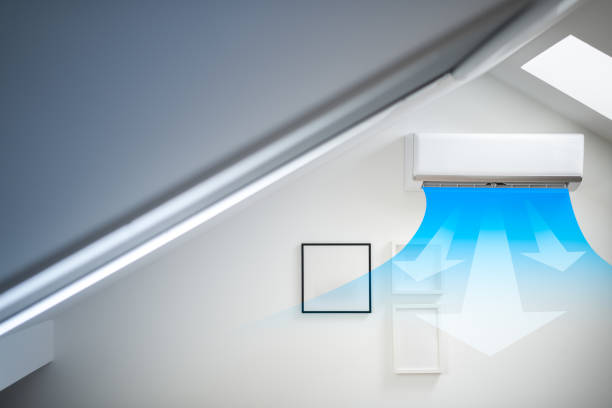
Investing in attic fans with thermostats gives homeowners multiple benefits for improved comfort and efficiency. These specialized ventilation systems offer many advantages through their smart design and automatic operation.
1. Automatic temperature control
Thermostat controlled attic fans monitor and respond to temperature changes without manual adjustments. With adjustable settings usually between 60°F to 120°F these systems turn on when needed. Advanced models have multi-speed functionality—low at 80°F, medium at 100°F, high at 110°F. This proactive approach keeps attic temperature within 5-10 degrees of outside air preventing extreme heat buildup.
2. Energy savings
Homeowners can expect 15-30% energy savings on cooling costs with thermostat controlled attic fans. Unlike standard fans that run continuously, thermostat-controlled fans operate selectively, using power only when needed. Many solar powered options further reduce energy consumption by operating during daylight hours when heat accumulation is highest.
3. Reduced strain on HVAC systems
These fans cool the attic, which can lower air conditioning use by up to 30%. As attic temperature decreases, less heat radiates down into living spaces, allowing HVAC systems to operate more efficiently. In fact, attic fans expel hot air that would otherwise force air conditioners to work harder and more frequently.
4. Mold and moisture prevention
Thermostat-controlled fans improve air circulation, helping to eliminate the damp conditions that lead to mold growth. Models with humidistats can be set to turn on at specific humidity levels, usually between 30% and 90%, to combat moisture accumulation. This feature is especially useful in winter when warm indoor air meets cold attic surfaces and creates condensation risks.
5. Roof and shingle protection
Proper ventilation extends the life of roofing materials. Excessive heat and moisture in poorly ventilated attics accelerate shingle aging and warp roof decking. By keeping the attic cooler and drier thermostat controlled fans prevent premature deterioration of roofing components and potentially save homeowners thousands in replacement costs.
6. Quiet and low maintenance
Modern attic fans are very quiet—49 dBA for high-end models. This “whisper-quiet” performance allows for comfortable temperatures without noise. Many premium systems have German engineered motors rated for 40,000+ hours of operation with minimal maintenance.
How to choose the right attic fan for your space
Choosing the right attic fan requires understanding several technical specifications to match your attic’s unique needs. A properly sized and installed unit maximizes ventilation benefits and minimizes operational costs.
What does CFM 576 mean?
CFM (cubic feet per minute) measures an attic fan’s airflow capacity. A 576 CFM rating means the fan can move 576 cubic feet of air every minute. It’s suitable for attics up to approximately 1,300 square feet. The Home Ventilation Institute recommends attic fans provide 10 air volume changes per hour. This rating determines how well a fan can ventilate your space; higher CFM values mean more cooling power.
Sizing based on attic square footage
To determine the right size attic fan for your space, measure the square footage of your attic (length x width). Once you have that number, multiply it by 0.7 to get your fan’s minimum required CFM (cubic feet per minute). If your roof is steep, add 20% to the result; if your roof is dark, add 15% since both conditions create more heat buildup.
For example, if your attic is 1,000 square feet, you’ll need at least a 700-CFM fan (1,000 x 0.7 = 700). Also, make sure you have enough intake ventilation. To figure this out divide the fan’s CFM rating by 300—that will tell you the minimum square feet of intake vent area required for proper airflow.
Electric vs solar powered
Electric fans provide consistent performance regardless of weather but increase energy costs. Solar powered models like the 10-inch 576 CFM Shutter Exhaust Fan provide eco-friendly operation with zero electricity costs.
Electric fans are more powerful and cheaper upfront (USD 50-100) but add to energy bills. Solar fans are eco-friendly, with an 800-1200 CFM capacity, higher initial cost (USD 200- 300+), but longer warranties (up to 25 years)
Conclusion: Why Every Home Needs a Thermostat-Controlled Attic Fan
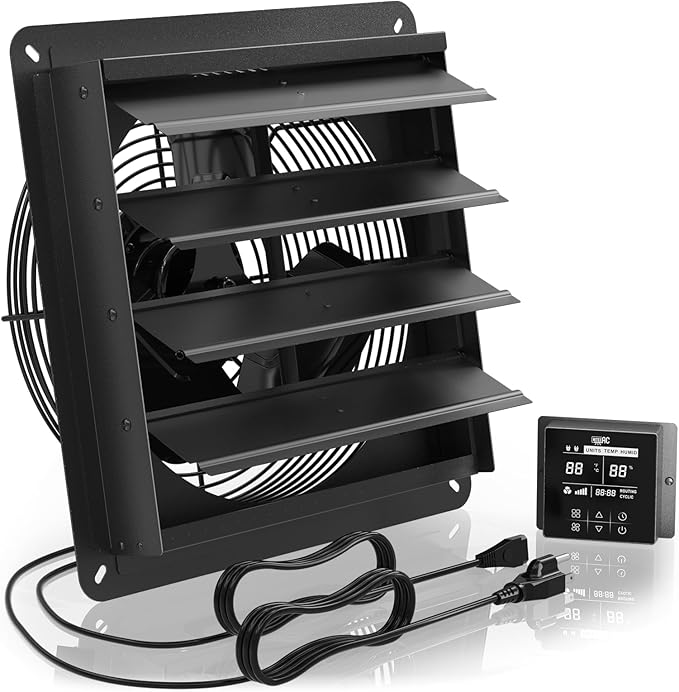
A thermostat controlled attic fan is more than a home upgrade. It’s a year round protection system that balances climate, saves your roof and reduces energy bills. Whether you live in a hot summer or cold winter region this one device can make a noticeable difference in comfort and efficiency. Among the options the 576 CFM Shutter Exhaust Fan stands out for its performance, quiet operation and energy smart design.
It ventilates up to 1,300 square feet and is perfect for most homeowners. From reducing moisture risks to preserving shingles and easing HVAC strain, these fans check every box on the smart-home list. By choosing a thermostat controlled fan especially one that also monitors humidity you’re investing in long term peace of mind, savings and comfort.
Upgrade your attic ventilation today with the powerful and efficient attic fan options from Aitecac. Explore the 10-inch 576 CFM Shutter Exhaust Fan to experience optimal airflow, smart thermostat features, and reliable performance for your home.

